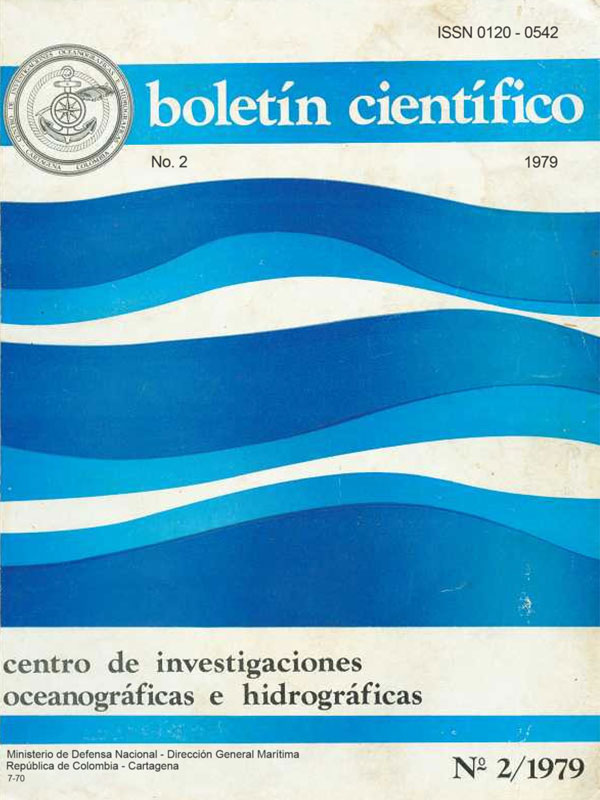Ceratium Schrank (peridinales) en la Bahía de Cartagena
DOI:
https://doi.org/10.26640/22159045.7Keywords:
Cartagena Bay, genus Ceratium SchrankAbstract
Twenty species of the genus Ceratium Schrank are described and also some varieties and transmition forms for Cartagena Bay (10º 25' N and 75º 30' W) during November 1975 through October 1976.
Photomicrographies were taken and some quantitative notes were done with a small taxonomical and ecological discussion.
The most important species of the genus were C. thichoceros, C. hicus, C. fusus, C. furca and C. tripos.
Downloads
References
BALECH, E. 1962. Tintinnoinea y Dinoflagellata del Pacífico según material de las expediciones Norpac y Downwind del Instituto Scripps de Oceanografía. REV. MUS. ARG. C1ENC. NAT. (ZOOL.), 7 -(1): 1-253.
BÖHM, A. 1931. Distribution and variability of Ceratiurn in the northern and western Pacific. BULL. BISHOP MUS., Honolulu, 87: 3-46.
CURL, H., Jr. 1959. The phytoplankton of Apalachee Bay and the Northeastern Gulf of Mexico. PUBL. INST. MAR. SCI., 6: 277-320.
DAVIS, J. T. 1964. Ceratium fusus (Ehr.) Dujardin. FLA. BD . CONSERV. MAR. LAB., Leaf. Ser., 1 (6): 3p.
DAVIS, J. T. 1965. Ceratium hexacantum Gourret. FLA. BD . CONSERV. MAR. LAB., Leaf. Ser., (9): 3p.
DAVIS, J. T. & K.A. STEIDINGER. 1966. Ceratium trichoceros (Ehrenberg) Kofoid. FLA. BD. CON: SERV. MAR. LAB., Leaf, Ser., 1., pt. 1, 1, 3p.
GRAHAM, H.W., & N. BRONIKOVSKY. The genus Ceratium in the Pacific and North Atlantic Oceans. CARNEGIE INST. WASH. PUBL.. 565: 1-209.
HASLE, G.R., & E. NORDLI. 1951. Form variation in Ceratium tusus and tripos populations in cultures & from the sea. AVH. NORSKE VIDENSK AKAD., OSLO, I: MAT.- NATURV.KL.,4: 1-25.
HASSAN, D. & S.M. SAIFULLAH. 1974 The genus Ceratium Schrank from Coastal Waters of Karachi. Part. I. The Sub-genera Amphiceratium and Biceratium. BOTANICA MARINA, 17(2): 82-87.
JÖRGENSEN, E. Mediterranean Ceratia. REP. DAN. OCEANOGR. EXPED. MEDITER., 2 (Biol. J. 1): 1-110.
LOPEZ. J. 1966. Variación y regulación de la forma en el género Ceratium. INV. PESO., Barcelona, (30): 325-427.
MONCALEANO, S. & L. M. NIÑO. 1976. Celenterados Planctónicos de la Bahía de Cartagena. Descripción. Distribución y notas Ecológicas. Tesis de Grado, Universidad de Bogotá Jorge Tadeo Lozano. 236 p.
NIE, D. 1936. Dinoflagellata of the Hainan Region, 1. Ceratium. CONTRIB. BIOL. LAB. SCI. SOC. of CHINA, Zool. Ser., XII (3): 29-73.
SCHAUS, R.H. 1974a. Circulación y transporte de agua en la Bahía de Cartagena de Indias mediante su representación por el modelo hidrodinámico numérico de la circulación. DIV. OCEAN. DO-20, DIR. GEN. MAR. PORT. ARM. NAC., Colombia: 49 p.
SCHAUS, R.H. 1974b. La estimación del periodo de renovación de las aguas en un estuario o una Bahía con aplicaciones en la Bahía de Cartagena de Indias, Septiembre 1974. DIV. OCEAN. 00-21, DIR. GEN. MAR. PORT. ARM. NAC., Colombia: 27 p.
SCHILLER, J. 1937. DINOFLAGELLATAE (PERIDINEAE) in monographischer Behandlung. (teil 2). RABENHORSTS KRYPTOGAMEN- FLORA, Leipzig, 10(3), pp. 1-589.
SOURNIA, A. 1966. Sur la variabilité infraspécifique du genre Ceratium (Péridime planctonique) en milieu marin. C.R.ACAD. SCI. Paris, 263 (25): 1980-1983.
SOURNIA, A. 1968. Le genre Ceratium (Péridinien planctonique) dans le Canal de Mozambique. Contribution a une Révision Mondiale. VIE ET MILIEU, 18 (2-3-A): 375-500.
SOURNIA, A. 1973. Catalogue des especes et taxons infraspécifiques de Dinoflagellés marins actuels. I. Dinoflagellés libres. NOVA HEDWIGIA, Beih. 48: 1-92.
STEIDINGER, K.A. & J. WILLIAMS. 1970. Dinoflagellates. MEM. HOURGLASSCRUISES. MAR. RES. LAB., 2,251 p.
VIDAL, L.A.& M.C. CARBONELL. Ined. Diatomeas y Dinoflagelados de la Bahía de Cartagena. Tesis de Grado. Universidad Jorge Tadeo Lozano. Bogotá, 1977, 360 p., 56 lam.
WALL, D. & W. EVITT. 1975 A comparison of the modern genus Ceratium Schrank, 1793, with certain Cretaceous marine dinoflagellates. MICROPALEONT., 21(1): 14-44.
WOOD, E.J.F. 1968. Dinoflagellates of the Caribbean Sea and adjacent areas. UNIV. MIAMI. PRESS., 143 P.
Downloads
Published
Issue
Section
License
Attribution — You must give appropriate credit, provide a link to the license, and indicate if changes were made. You may do so in any reasonable manner, but not in any way that suggests the licensor endorses you or your use.
NonCommercial — You may not use the material for commercial purposes.
NoDerivatives — If you remix, transform, or build upon the material, you may not distribute the modified material.
No additional restrictions — You may not apply legal terms or technological measures that legally restrict others from doing anything the license permits.



